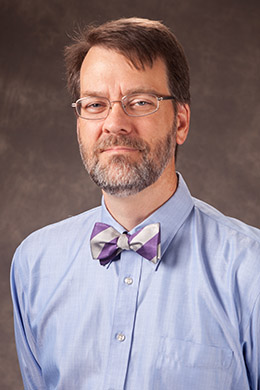
CONWAY, Ark (November 7, 2013) – What do Aldous Huxley, President John F. Kennedy,
and C.S. Lewis have in common?
Ask Hendrix art history professor Dr. Rod Miller.
The answer is all three died on November 22, 1963. This year is the 50th
anniversary of their deaths.
Miller is most interested in the latter. He recently completed a book titled
C.S. Lewis and the Arts: Creativity in the Shadowlands.
The book, which will be published November 29 by Square Halo Books, is a collection
of essays by a who’s who of Lewis scholars. Contributors include David C. Downing,
Bruce Herman, Scott B. Key, Don W. King, Jerry Root, David Rozema, Peter J. Schakel,
Charlie W. Starr, Will Vaus, and Theodore Prescott (foreword). Miller, who served
as editor, also contributed an essay.
The seeds of the project were sewn when Miller was a child.
“I was read The Lion, the Witch, and the Wardrobe as a kid,” said Miller,
referring to The Chronicles of Narnia. “When I was a little older, I saved
my money for a set of the Narnia books.”
He later discovered Lewis' science fiction trilogy as well as Lewis’ final novel, ‘Til
We Have Faces.
Not only does Miller keep company with contemporary Lewis scholars, he is a trove
of Lewis trivia. For example, Lewis was a member of a group of writers called The
Inklings which included author J. R. R. Tolkien.
It’s possible that, without Lewis’ encouragement Tolkien, Lord of the Rings
would never have been written, said Miller, adding his pleasure at Lewis’ installation
this year in Westminster Abbey’s Poet’s Corner.
Lewis’ first passion was to be a poet and did publish a book of poems and other
individual poems. But he realized poetry wasn’t his strong suit, Miller said.
“It was a good thing … because he applied his poetic tendencies to his prose,
which gives his writing an amazingly imaginative quality,” he said.
Miller then began to explore the author’s nonfiction writing when a friend lent
him a collection of Lewis essays on theological topics. While Lewis’ academic work
concentrated on Medieval and Renaissance literature, it is his theological essays
and books that garnered him such a large following in America.
Lewis’ Mere Christianity was based on a series of religious talks Lewis
gave during World War II. The talks were broadcast on the BBC and made Lewis the
second most recognized voice in England, after Winston Churchill. Lewis wanted to
make his language accessible to everyone, but he was criticized by some of his academic
peers because he wasn’t a trained theologian, Miller said.
Seven years ago, Miller got a collection of Lewis essays, available only in England,
which included several on Christianity and culture.
As an art historian and an active lay leader in his church, Miller was drawn
to Lewis’ discussion of what value the arts hold to Christians and what it means
to be a creative Christian.
“Little has been written about Lewis understanding of arts and culture,” said
Miller on the focus of his book, which will join a number of new analyses of Lewis
published during the 50th anniversary of the author’s death. Miller’s
publisher has indicated early interest in a second edition of the book.
Miller prepared the original version of his book essay for a presentation at
the 2005 Art and Soul Conference at Baylor University in Waco, Texas.
“It got a good reception, so I wanted to make it bigger,” said Miller, who expanded
the original version by 20 pages. The expanded version was later published in the
journal of the Oxford C.S. Lewis Society.
Miller found Lewis’ support for the arts, in some of his essays, rather tepid,
given that much of his career was dedicated either to the study or creation of literary
works.
“I was surprised to find, given his profound claims for objective ethics, that
he often made a mess of confusing beauty and aesthetics.”
But not everywhere.
“Occasionally, Lewis makes clear a claim for a beauty that goes beyond mere pleasure,”
said Miller, who leaves the last word for Lewis.
“An author should never conceive himself as bringing into existence beauty or
wisdom which did not exist before, but simply and solely as trying to embody in
terms of his own art some reflection of eternal Beauty and Wisdom ...”
For more information on the book, visit
http://www.squarehalobooks.com/cslewis.html.
Founded in 1876, Hendrix College is a national leader in engaged liberal arts
and sciences education. For the fifth consecutive year, Hendrix was named one of
the country’s “Up and Coming” liberal arts colleges by U.S. News and World Report.
Hendrix is featured in the 2012 edition of the Princeton Review as one of the country’s
best 377 colleges, the latest edition of Colleges That Change Lives: 40 Schools
That Will Change the Way You Think about Colleges, Forbes magazine's
annual list of America's Top 650 Colleges, and the 2013 edition of the Fiske Guide
to Colleges. Hendrix has been affiliated with the United Methodist Church since
1884. For more information, visit www.hendrix.edu.